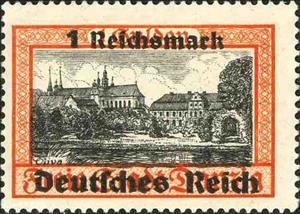Stamp: Stamps of Danzig surch Deutsches Reich and new values. (Austria 1939)
Stamps of Danzig surch Deutsches Reich and new values. (Austria 1939)
28 September (Austria ) within release German Realm stamps used in Austria 1938-1945 goes into circulation Stamp Stamps of Danzig surch Deutsches Reich and new values. face value 1 German reichsmark
| Stamp Stamps of Danzig surch Deutsches Reich and new values. in catalogues | |
|---|---|
| Michel: | Mi: DR-AT 728Y |
| ANK: | ANK: DR-AT 728y |
Stamp is horizontal format.
Mi: DR 728 Used stamp only. Stamp or cut off must bear readable cancellation from Austria during the occupation period or before the expiry date.Also in the issue German Realm stamps used in Austria 1938-1945:
- Stamp - Stamps of Danzig surch Deutsches Reich and new values. face value 3;
- Stamp - Stamps of Danzig surch Deutsches Reich and new values. face value 4;
- Stamp - Stamps of Danzig surch Deutsches Reich and new values. face value 5;
- Stamp - Stamps of Danzig surch Deutsches Reich and new values. face value 8;
- Stamp - Stamps of Danzig surch Deutsches Reich and new values. face value 10;
- Stamp - Stamps of Danzig surch Deutsches Reich and new values. face value 12;
- Stamp - Stamps of Danzig surch Deutsches Reich and new values. face value 1;
- Stamp - Stamps of Danzig surch Deutsches Reich and new values. face value 1;
- Stamp - Stamps of Danzig surch Deutsches Reich and new values. face value 2;
- Stamp - Stamps of Danzig surch Deutsches Reich and new values. face value 2;
- Stamp - Stamps of Danzig surch Deutsches Reich and new values. face value 15;
- Stamp - Stamps of Danzig surch Deutsches Reich and new values. face value 20;
- Stamp - Stamps of Danzig surch Deutsches Reich and new values. face value 25;
- Stamp - Stamps of Danzig surch Deutsches Reich and new values. face value 30;
- Stamp - Stamps of Danzig surch Deutsches Reich and new values. face value 40;
- Stamp - Stamps of Danzig surch Deutsches Reich and new values. face value 50;
- Stamp - Stamps of Danzig surch Deutsches Reich and new values. face value 2;
- Stamp - Stamps of Danzig surch Deutsches Reich and new values. face value 2;
Stamp Stamps of Danzig surch Deutsches Reich and new values. it reflects the thematic directions:
A building or edifice is a structure with a roof and walls standing more or less permanently in one place, such as a house or factory. Buildings come in a variety of sizes, shapes and functions, and have been adapted throughout history for a wide number of factors, from building materials available, to weather conditions, to land prices, ground conditions, specific uses and aesthetic reasons. Buildings serve several needs of society – primarily as shelter from weather, security, living space, privacy, to store belongings, and to comfortably live and work. A building as a shelter represents a physical division of the human habitat (a place of comfort and safety) and the outside (a place that at times may be harsh and harmful).
A castle (from Latin: castellum) is a type of fortified structure built in Europe and the Middle East during the Middle Ages by European nobility. Scholars debate the scope of the word castle, but usually consider it to be the private fortified residence of a lord or noble. This is distinct from a palace, which is not fortified; from a fortress, which was not always a residence for nobility; and from a fortified settlement, which was a public defence – though there are many similarities among these types of construction. Usage of the term has varied over time and has been applied to structures as diverse as hill forts and country houses. Over the approximately 900 years that castles were built, they took on a great many forms with many different features, although some, such as curtain walls and arrowslits, were commonplace.
A palace is a large residence, often serving as a royal residence or the home for a head of state or another high-ranking dignitary, such as a bishop or archbishop. The word is derived from the Latin name palātium, for Palatine Hill in Rome which housed the Imperial residences



